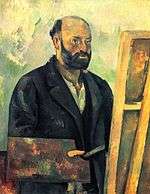The Bathers (Cézanne)
 | |
| Artist | Paul Cézanne |
|---|---|
| Year | 1898–1905 |
| Medium | Oil-on-canvas |
| Dimensions | 210.5 cm × 250.8 cm ( 82 7⁄8 in × 98 3⁄4 in) |
| Location | Philadelphia Museum of Art, Philadelphia, United States |
The Bathers (French: Les Grandes Baigneuse) is an oil painting by French artist Paul Cézanne first exhibited in 1906. The painting is the largest of a series of "Bather" paintings by Cézanne; the others are in the Museum of Modern Art in New York City, National Gallery, London, the Barnes Foundation, Philadelphia, and the Art Institute of Chicago.[1][2][3][4] Occasionally referred to as the Big Bathers or Large Bathers to distinguish it from the smaller works, the painting is considered one of the masterpieces of modern art,[2][5] and is often considered Cézanne's finest work.[6]
Cézanne worked on the painting for seven years, and it remained unfinished at the time of his death in 1906.[7] The painting was purchased in 1937 for $110,000 with funds from a trust fund for the Philadelphia Museum of Art by their major benefactor Joseph E. Widener.[1][2] It was previously owned by Leo Stein.[8]
With each version of the bathers, Cézanne moved away from the traditional presentation of paintings, intentionally creating works which would not appeal to the novice viewer.[9] He did this in order to avoid fleeting fads and give a timeless quality to his work, and in so doing paved the way for future artists to disregard current trends and paint pieces which would appeal equally to all generations.[9] The abstract nude females present in Large Bathers give the painting tension and density.[9] It is exceptional among his work in symmetrical dimensions, with the adaptation of the nude forms to the triangular pattern of the trees and river.[10] Using the same technique as employed in painting landscapes and still lifes, Large Bathers is reminiscent of the work of Titian and Peter Paul Rubens.[11] Comparisons are also often made with the other famous group of nude women of the same period, Picasso's Les Demoiselles d'Avignon.[12][13]
The purchase of the painting, while generally praised, was nevertheless questioned by The Philadelphia Record, which noted that 41,000 (or ten percent) of Philadelphia's residents were without bathtubs, and that the money could therefore have been better spent elsewhere.[2] While Cézanne's drawing ability has always been criticized, a critic once said that he "made the ineptly drawn Bathers a warm evocation of leisurely summer bliss."[14] The painting was featured in the BBC Two series 100 Great Paintings.
Other versions
 Bathers, 1874–1875, Metropolitan Museum of Art, New York City
Bathers, 1874–1875, Metropolitan Museum of Art, New York City Bathers (Les Grandes Baigneuses) (1894–1905). 127.2 × 196.1 cm. National Gallery, London
Bathers (Les Grandes Baigneuses) (1894–1905). 127.2 × 196.1 cm. National Gallery, London Bathers, 1900–1905, Chicago Art Institute
Bathers, 1900–1905, Chicago Art Institute
References
- 1 2 A Cold Plunge, Time, 1965-02-12, retrieved 2008-03-07
- 1 2 3 4 Cezanne, Cezanne, Time, 1937-11-29, retrieved 2008-03-06
- ↑ Brown, Mark (2006-02-15), Cézanne, reclusive 19th century genius, gets recognition he craved a century on, The Guardian, retrieved 2008-03-07
- ↑ Anderson, Porter (2005-06-28), Review: MoMA reunites Cezanne and Pissarro, CNN, retrieved 2008-03-07
- ↑ Kimmelman, Michael (1996-06-09), ART VIEW;Cezanne, in All His Magnificent Mystery, New York Times, retrieved 2008-03-07
- ↑ Riding, Alan (1995-10-24), Cezanne: The Hot New Artist of the 90's, New York Times, retrieved 2008-03-07
- ↑ Murphy, Richard A (1968). The World of Cézanne. New York: Time-Life Books. p. 114.
- ↑ Sheets, Hilarie (3 June 2011). "Exhibition Shows Fierce Art Patronage of the Fierce Steins". The New York Times. Retrieved 6 June 2011.
- 1 2 3 Walther, Ingo F. (2002), Masterpieces Of Western Art: A History Of Art In 900 Individual Studies, Taschen, p. 512, ISBN 3-8228-1825-9
- ↑ Schapiro, Meyer (1988). Cézanne, New York: Harry N. Abrams, p.44. ISBN 0-8109-1043-8.
- ↑ Bossy, Michel-Andre (2001), Artists, Writers, and Musicians: An Encyclopedia of People Who Changed the World, Greenwood Publishing Group, p. 39, ISBN 1-57356-154-1
- ↑ Les Demoiselles D'Avignon: Picasso's influences in the creation of a masterwork, retrieved 2008-03-10
- ↑ Turner, Jane (1996), Grove Dictionary of Art, Macmillan Publishers, p. 372, ISBN 1-884446-00-0
- ↑ I Am a Timid Man, Time, 1952-02-04, retrieved 2008-03-07
External links
| Wikimedia Commons has media related to Paul Cézanne#Bathers. |
